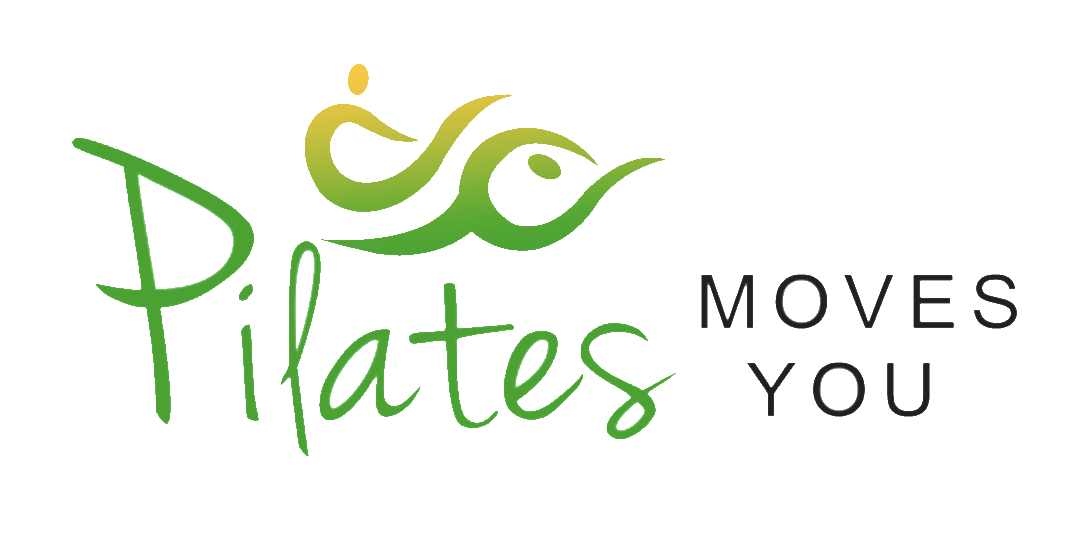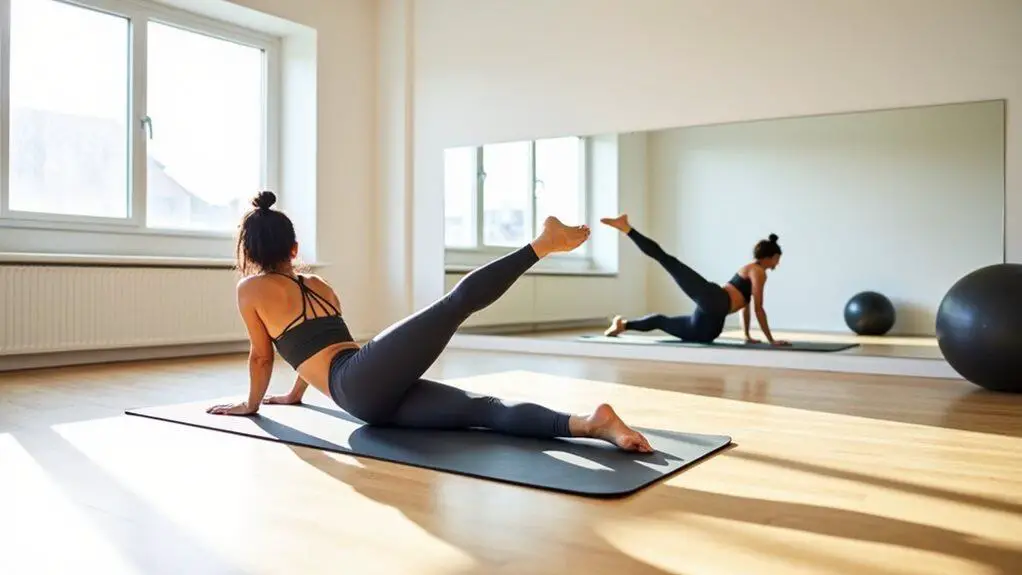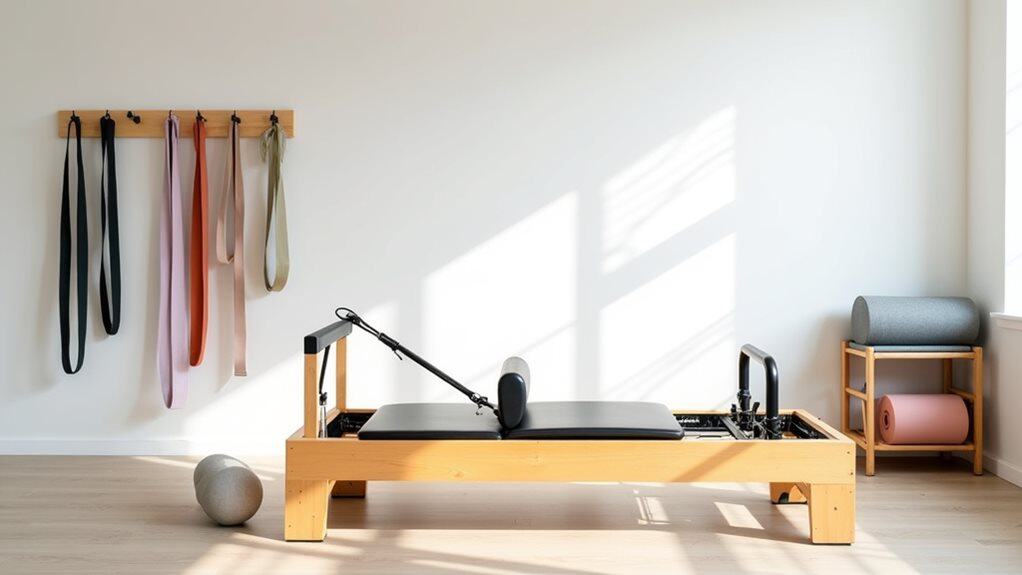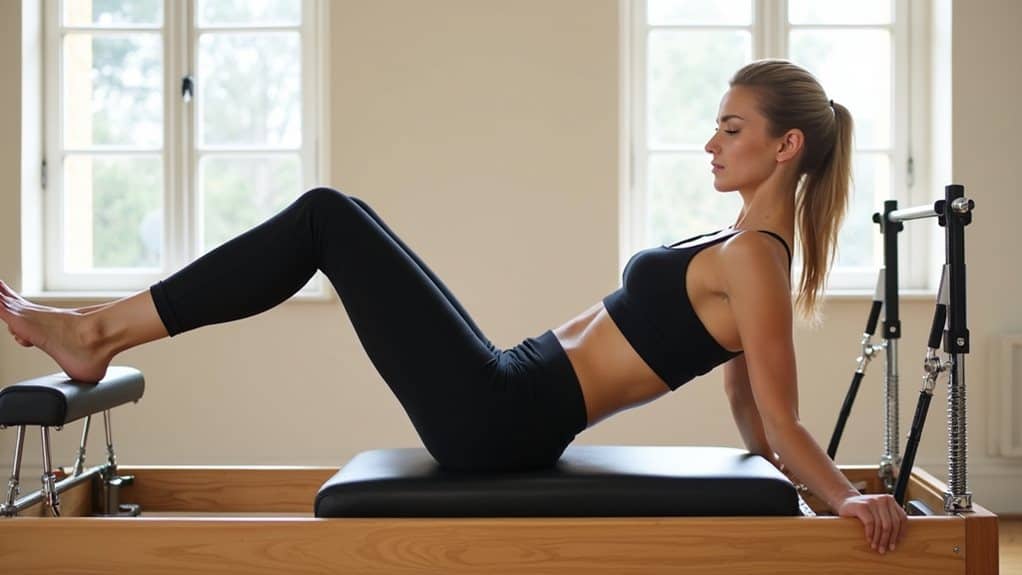Are you ready to unlock your full potential and achieve a stronger, more balanced body? Look no further than Pilates Reformer. This revolutionary exercise method is designed to challenge every muscle in your body while improving overall flexibility, range of motion, and posture.
In this article, we will explore the essential techniques of Pilates Reformer and how they can help you achieve your fitness goals. From building core strength and stability to enhancing balance and coordination, Pilates Reformer is a comprehensive workout that can be adapted to meet your individual needs and preferences.
Join us as we dive into the fundamentals of this transformative exercise method and discover how it can help you unleash your full potential.
Key Takeaways
- Understanding basic principles and safety precautions is essential for mastering Pilates Reformer techniques and preventing injuries.
- Building core strength and stability is crucial in Pilates Reformer and involves engaging deep muscles in the abdomen, and can support the spine and maintain proper alignment.
- Personalizing Pilates Reformer practice and combining it with other forms of exercise can enhance physical abilities and overall well-being.
- Pilates Reformer can provide both physical and mental benefits, including improving posture, reducing stress, promoting body awareness, and achieving a sense of calm and relaxation. Consistency and progression are key to achieving fitness goals through Pilates Reformer practice, and tracking progress and results can help maintain consistency and avoid burnout or injury.
Understanding the Fundamentals of Pilates Reformer
You’ll need to understand the basic principles of Pilates Reformer to truly unlock your full potential and reap the benefits of this transformative exercise.
Before you start your Pilates Reformer journey, it’s essential to get familiar with the basic equipment. Pilates Reformer is a machine that consists of a sliding carriage, straps and springs that provide resistance. The carriage is attached to a frame with springs that can be adjusted to change the resistance level. The straps are used to hold your arms or legs in place during certain exercises.
Once you are familiar with the equipment, it’s important to start with beginner exercises. These exercises will help you gain an understanding of how Pilates Reformer works and how it can benefit your body. Some of the beginner exercises include footwork, leg circles, and the hundred. These exercises may seem simple, but they target specific areas of the body and help build a strong foundation for more complex movements.
While Pilates Reformer is a safe and effective form of exercise, it’s essential to take safety precautions and prevent injuries. Always follow the instructions of a qualified instructor and make sure you’re using the equipment correctly. It’s also important to listen to your body and not push yourself too hard. If you experience any discomfort or pain, stop the exercise immediately and consult your instructor.
Understanding the fundamentals of Pilates Reformer is just the first step. To truly master this exercise, you need to practice consistently and focus on perfecting your technique. In the next section, we’ll discuss how to master the principles of Pilates Reformer and take your practice to the next level.
Mastering the Principles of Pilates Reformer
By understanding the basic principles of Pilates Reformer, you can improve your technique and achieve better results in your workouts. Mastering technique and refining form are key to achieving excellence in Pilates Reformer. Incorporating breathwork and mindfulness techniques can also help unlock the full potential of Pilates Reformer.
To master technique, it is important to focus on proper alignment, control, and precision. The following table outlines these principles and their corresponding benefits:
| Principle | Benefit |
|---|---|
| Alignment | Improves posture and reduces risk of injury |
| Control | Enhances coordination and stability |
| Precision | Increases effectiveness of exercises |
In addition to mastering technique, incorporating breathwork and mindfulness can also enhance your Pilates Reformer practice. By focusing on your breath and being present in the moment, you can deepen your mind-body connection and improve overall performance.
In summary, by mastering technique and incorporating breathwork and mindfulness, you can unlock the full potential of Pilates Reformer and achieve greater results in your workouts. In the next section, we will explore how building core strength and stability can further enhance your Pilates Reformer practice.
Building Core Strength and Stability
To build strong and stable core muscles, focus on engaging your abs and maintaining a steady, controlled movement throughout your Pilates Reformer exercises. Core activation is crucial in Pilates, and it involves engaging the deep muscles in your abdomen, including the transverse abdominis, obliques, and rectus abdominis.
By engaging these muscles, you can build strength and stability in your core, improving your posture and balance. Breath work is also important when building core strength and stability during Pilates Reformer exercises. As you engage your core muscles, inhale deeply through your nose and exhale slowly through your mouth, which can help you maintain control and stability while performing the exercises.
Incorporating props and variations can also help you build core strength and stability during your Pilates Reformer practice. For example, using a resistance band or a small ball can add an extra challenge to your exercises and increase the engagement of your core muscles. By incorporating these props and variations, you can continue to challenge your core muscles and improve your strength and stability.
To improve flexibility and range of motion, focus on incorporating stretching exercises into your Pilates Reformer practice. By stretching your muscles, you can increase your flexibility and range of motion, helping you move more freely and easily in your daily life.
Keep in mind that building core strength and stability is just one part of a well-rounded Pilates practice, and incorporating stretching exercises can help you achieve a balanced and effective workout.
Improving Flexibility and Range of Motion
Get ready to feel more fluid and graceful in your movements as we explore ways to increase your flexibility and range of motion during your Pilates Reformer practice. Pilates is all about balance and harmony, and a flexible body is essential to achieve that. Stretching techniques and flexibility routines are fundamental to improving your Pilates practice and unlocking your full potential.
To get started, let’s take a look at this table that outlines some of the best stretching techniques to incorporate into your Pilates Reformer practice. Each stretch targets a specific muscle group and can help improve your flexibility and range of motion. Incorporating these stretches into your routine will help you achieve a more fluid and graceful Pilates practice.
| Stretching Technique | Muscle Group | Benefits |
|---|---|---|
| Hamstring stretch | Hamstrings | Increases flexibility in the legs and lower back |
| Spinal Twist | Lower back and hips | Increases mobility and flexibility in the spine |
| Quad stretch | Quadriceps | Improves flexibility in the hips and thighs |
| Shoulder opener | Shoulders and chest | Improves posture and shoulder mobility |
In addition to specific stretching techniques, it’s important to incorporate flexibility routines into your Pilates practice. These routines can include exercises that focus on improving flexibility in the hips, spine, and shoulders. By improving your flexibility, you’ll be able to move more freely and with greater ease during your Pilates practice.
As you work on improving your flexibility and range of motion, you’ll also be enhancing your overall balance and coordination. In the next section, we’ll explore some techniques and exercises that can help you achieve greater balance and coordination during your Pilates practice. Let’s continue on this journey to unlock your full potential!
Enhancing Balance and Coordination
Let’s explore how we can improve our balance and coordination in Pilates Reformer practice, so we can move with more grace and control. Improving stability is essential in any physical activity, and Pilates Reformer is no exception. When we’re stable, we can move with intention and fluidity.
Pilates Reformer exercises that focus on balance, such as the Tree or the Single Leg Circles, can help us develop a strong core and better body awareness. Enhancing body control is another key aspect of Pilates Reformer practice. By using resistance and adjusting the springs, we can challenge ourselves to move with precision and control.
The more we practice, the more we can fine-tune our movements and develop a deeper understanding of our body’s capabilities. Exercises like the Short Spine Massage or the Plank on the Reformer can help us improve our body control and overall Pilates Reformer practice.
Incorporating balance and coordination exercises into our Pilates Reformer routine can have numerous benefits for our overall health and well-being. By improving stability and enhancing body control, we can move with more grace and ease, reducing the risk of injury and improving our overall physical performance.
In the next section, we’ll explore how correcting our posture and alignment can further enhance our Pilates Reformer practice.
Correcting Posture and Alignment
We need to discuss the impact of poor posture on our physical and mental health, and how we can correct it through essential exercises.
Poor posture can lead to back pain, neck pain, headaches, and decreased lung capacity.
Correcting posture and alignment can improve our overall health and well-being.
We’ll also discuss modifications for different levels and abilities to ensure everyone can benefit from these exercises.
Let’s use contractions to make the language more natural.
The Impact of Poor Posture on Physical and Mental Health
Having bad posture not only affects physical health, but can also have a negative impact on mental well-being. As we spend more time sitting and staring at screens, it’s important to be mindful of the way we hold our bodies.
Here are three ways poor posture can affect both our physical and mental health:
- Impact on work productivity: Poor posture can lead to discomfort, pain and fatigue, which can all have a negative impact on work productivity. When we’re constantly adjusting ourselves to find a comfortable position, it’s harder to focus on the task at hand.
- Increased stress and anxiety: When we slouch or hunch over, it can restrict our breathing and make it harder to take deep, calming breaths. This can lead to increased stress and anxiety, which can have a negative impact on mental well-being.
- Decreased self-confidence: Good posture is associated with confidence and assertiveness, while poor posture can make us appear less confident and approachable. This can have a negative impact on our personal and professional relationships.
Improving posture outside of Pilates practice can involve simple adjustments like sitting up straight, taking frequent breaks to stretch and move around, and adjusting the height of our computer screens. By incorporating these habits into our daily lives, we can improve our physical and mental health.
Now, let’s dive into the essential exercises for correcting posture and alignment.
The Essential Exercises for Correcting Posture and Alignment
As we’ve learned, poor posture can have a significant impact on our physical and mental health. But the good news is that there are exercises we can do to correct our posture and improve our alignment. By incorporating these essential exercises into our workout routine, we can start to see improvements in our posture and overall well-being.
The first step in correcting posture is to focus on alignment techniques. This involves becoming aware of our body’s natural alignment and making adjustments to correct any imbalances. One example of an alignment technique is to lengthen the spine by lifting the crown of the head towards the ceiling while keeping the shoulders relaxed. Another technique is to engage the core muscles to support the spine and maintain proper alignment.
By incorporating these alignment techniques into our exercises, we can start to see improvements in our posture and overall alignment.
Speaking of exercises, our next topic will cover modifications for different levels and abilities. By making modifications to our exercises, we can ensure that we are challenging ourselves without risking injury. So, let’s dive into the different modifications that can be made for a safe and effective workout.
Modifications for Different Levels and Abilities
You can tailor your exercises to your own level and ability, ensuring a safe and effective workout that leaves you feeling confident and accomplished. Modifying the exercises for injuries is crucial to ensure that you are working within your limits and not causing further damage.
For example, if you have a knee injury, you can modify exercises like lunges by using the footbar instead of standing on the carriage. Similarly, if you have a back injury, you can adjust the springs to make the exercises less challenging.
Modifications for pregnancy are also necessary to ensure that the exercises are safe for both you and your baby. It’s important to avoid exercises that put too much pressure on the abdomen, such as the stomach massage series, and to use lighter springs to reduce the amount of resistance.
Additionally, if you experience any discomfort or pain during an exercise, it’s important to stop and consult with your healthcare provider before continuing. With these modifications, you can still enjoy the benefits of Pilates reformer while keeping yourself and your baby safe.
Moving forward, let’s explore how to adapt Pilates reformer to your needs and goals.
Adapting Pilates Reformer to Your Needs and Goals
Let’s talk about how you can adapt Pilates Reformer to fit your specific needs and goals. Customizing your practice is key to getting the most out of each session.
Private sessions with a certified instructor can help you achieve your goals faster and more effectively. Additionally, combining Pilates Reformer with other forms of exercise can enhance your overall fitness and wellbeing.
Adjusting the paragraph structure in this way allows for clearer and more concise communication of the ideas presented. Contractions are used to make the language more natural and conversational.
Customizing Your Pilates Reformer Practice
Customizing your Pilates Reformer practice allows for a personalized workout experience that targets specific areas of the body. With customizing techniques, you can tailor your practice to your unique needs and goals.
Here are two ways to personalize your practice:
- Adjust the resistance: The Pilates Reformer machine has different springs that can be adjusted to change the resistance of the exercises. Depending on your level of fitness and desired intensity, you can make the exercises easier or harder by adjusting the springs accordingly. This customization allows you to challenge yourself while still working within your limits.
- Focus on specific body areas: You can customize your Pilates Reformer practice by targeting specific areas of the body. Whether you want to work on your abs, legs, arms, or back, you can choose exercises that will focus on those areas. This personalization allows you to address any areas of weakness or imbalance in your body.
By customizing your Pilates Reformer practice, you can create a workout that is tailored to your needs and goals. This personalized approach can lead to greater results and a more enjoyable workout experience.
Let’s explore the benefits of private sessions with a certified instructor.
The Benefits of Private Sessions with a Certified Instructor
Maximize your results and experience a deeper level of connection with your body by booking private Pilates Reformer sessions with a certified instructor.
A private session allows for personalized guidance from an experienced instructor, who can tailor the workout to your specific needs and goals. This focused attention ensures proper form and technique, preventing injury and promoting maximum benefits.
Working with a certified instructor also allows for a more thorough understanding of the Pilates Reformer equipment and exercises. The instructor can provide explanations and demonstrations, as well as feedback on your technique. This level of attention and knowledge translates to a more effective and efficient workout, and a deeper understanding of your body’s capabilities.
By booking private sessions with a certified instructor, you can unlock your full potential and achieve your fitness goals with confidence.
As you progress in your Pilates Reformer practice, consider combining it with other forms of exercise to further enhance your physical abilities and overall well-being.
Combining Pilates Reformer with Other Forms of Exercise
Combining Pilates Reformer with other forms of exercise can enhance your physical abilities and overall well-being. Here are some reasons why this combination is worth considering:
- You can improve your flexibility and balance by incorporating Pilates Reformer with Yoga. Both practices emphasize the importance of proper alignment, breathing, and mindful movement. By doing Yoga before or after a Pilates Reformer session, you can prepare your body for the workout or help it recover from it. You can also benefit from the variety of poses and stretches that Yoga offers, which can complement the movements you perform on the Reformer.
- You can boost your cardiovascular health by adding some form of aerobic exercise to your Pilates Reformer routine. Whether it’s running, cycling, swimming, or dancing, cardio can help you burn calories, increase endurance, and reduce stress. By alternating between Pilates Reformer and cardio, you can challenge your body in different ways and prevent boredom or plateaus. You can also customize your workout to your fitness level and goals, by adjusting the intensity, duration, and type of cardio you do.
By combining Pilates Reformer with other forms of exercise, you can create a holistic approach to fitness that suits your preferences and needs. Whether you want to build strength, flexibility, balance, or endurance, you can find a way to achieve it by experimenting with different activities and modalities.
In the next section, we’ll discuss how to make Pilates Reformer a part of your lifestyle, by integrating it into your daily routine and setting realistic goals.
Making Pilates Reformer a Part of Your Lifestyle
Let’s discuss how to make Pilates Reformer a part of your lifestyle by creating a sustainable practice.
Consistency and progression are key to achieving your goals and reaping the benefits of this exercise.
We’ll also explore the connection between physical and mental health in Pilates Reformer practice and how it can enhance your overall well-being.
Creating a Sustainable Pilates Reformer Practice
Maintaining a regular Pilates reformer practice can help us build strength and flexibility over time. However, sustaining motivation and preventing injury can be a challenge. Here are some tips to create a sustainable Pilates reformer practice:
- Set realistic goals: Start by understanding your current fitness level and set achievable goals that align with your lifestyle. This will help you stay motivated and track your progress.
- Mix it up: Incorporate different Pilates reformer exercises and variations to keep your practice fresh and challenging. This will help prevent injury and boredom.
- Stay consistent: Create a routine that works for you and stick to it. Consistency is key to building strength and flexibility over time.
By following these tips, we can create a sustainable Pilates reformer practice that helps us achieve our fitness goals.
In the next section, we’ll discuss the benefits of consistency and progression in Pilates reformer practice.
The Benefits of Consistency and Progression
To get the most out of your Pilates reformer practice, it’s important to consistently challenge yourself and progress over time. Consistency versus intensity is a crucial concept to understand when it comes to Pilates reformer practice.
While it’s important to push yourself to your limits during your workouts, it’s equally important to maintain a consistent routine to see long-term results. Consistency builds a strong foundation, allowing you to gradually increase the intensity of your workouts and avoid burnout or injury.
Tracking progress and results is another important aspect of maintaining consistency in your Pilates reformer practice. Keep a record of your workouts, noting the exercises you’ve completed, the number of repetitions, and any modifications you’ve made. This will help you stay on track with your goals and monitor your progress over time.
By consistently challenging yourself and tracking your progress, you’ll be able to achieve your goals and unlock your full potential on the Pilates reformer.
Maintaining physical and mental health is crucial in any exercise routine, and Pilates reformer practice is no exception.
[Transition into the subsequent section about the connection between physical and mental health in Pilates reformer practice.]
The Connection between Physical and Mental Health in Pilates Reformer Practice
The mind-body connection is a crucial aspect of Pilates reformer practice. The fusion of physical movements and breathing techniques unites the mind and body, promoting overall health and wellness. While the physical benefits of Pilates reformer practice are well-known, the mental benefits are equally significant.
Here are three ways in which the mind-body connection in Pilates reformer practice can benefit your overall health and wellness:
- Reducing stress and anxiety: The controlled breathing techniques used in Pilates reformer practice can help to reduce stress and anxiety levels. By focusing on the breath and controlling it, practitioners can achieve a sense of calm and relaxation that can carry over into other areas of their lives.
- Improving focus and concentration: Pilates reformer practice requires a high level of focus and concentration. By training the mind to focus on the movements and the breath, practitioners can improve their overall ability to concentrate and focus, both on and off the reformer.
- Enhancing body awareness: Pilates reformer practice encourages practitioners to pay close attention to their bodies, becoming more aware of their strengths, weaknesses, and imbalances. This increased body awareness can lead to greater self-awareness and a deeper understanding of the mind-body connection.
In summary, the physical benefits of Pilates reformer practice are well-known, but the mental benefits are equally important. By focusing on the mind-body connection, practitioners can reduce stress and anxiety, improve focus and concentration, and enhance body awareness.
Final Thoughts
In conclusion, mastering the essential techniques of Pilates Reformer can unlock your full potential and help you achieve your fitness goals.
By understanding the fundamentals and principles of Pilates Reformer, you can build core strength and stability, improve flexibility and range of motion, enhance balance and coordination, and correct posture and alignment.
Adapting Pilates Reformer to your needs and goals is important for making it a part of your lifestyle.
Whether you want to improve your athletic performance, recover from an injury, or simply feel better in your body, Pilates Reformer can help you achieve your desired results.
So why not give it a try and see how it can transform your physical and mental well-being?
With dedication and practice, you can become a master of Pilates Reformer and unlock your full potential.




